Korean Short Ribs
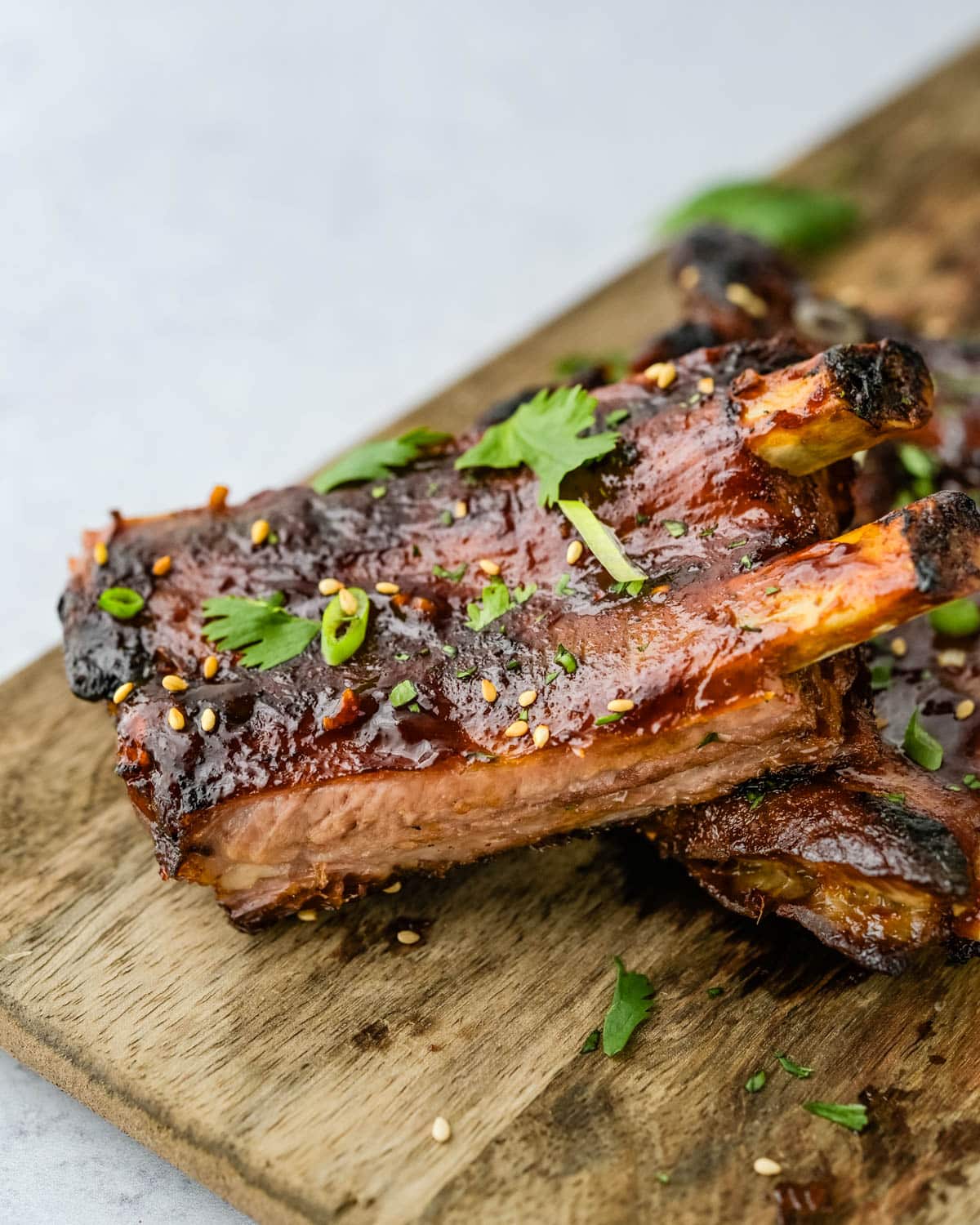
These Korean short ribs are sweet, sticky, tangy, spicy, and delicious. In short, the best Asian-style short ribs you can make at home. This easy dish includes a versatile Korean BBQ sauce for marinating, brushing and dipping this Korean ribs recipe.
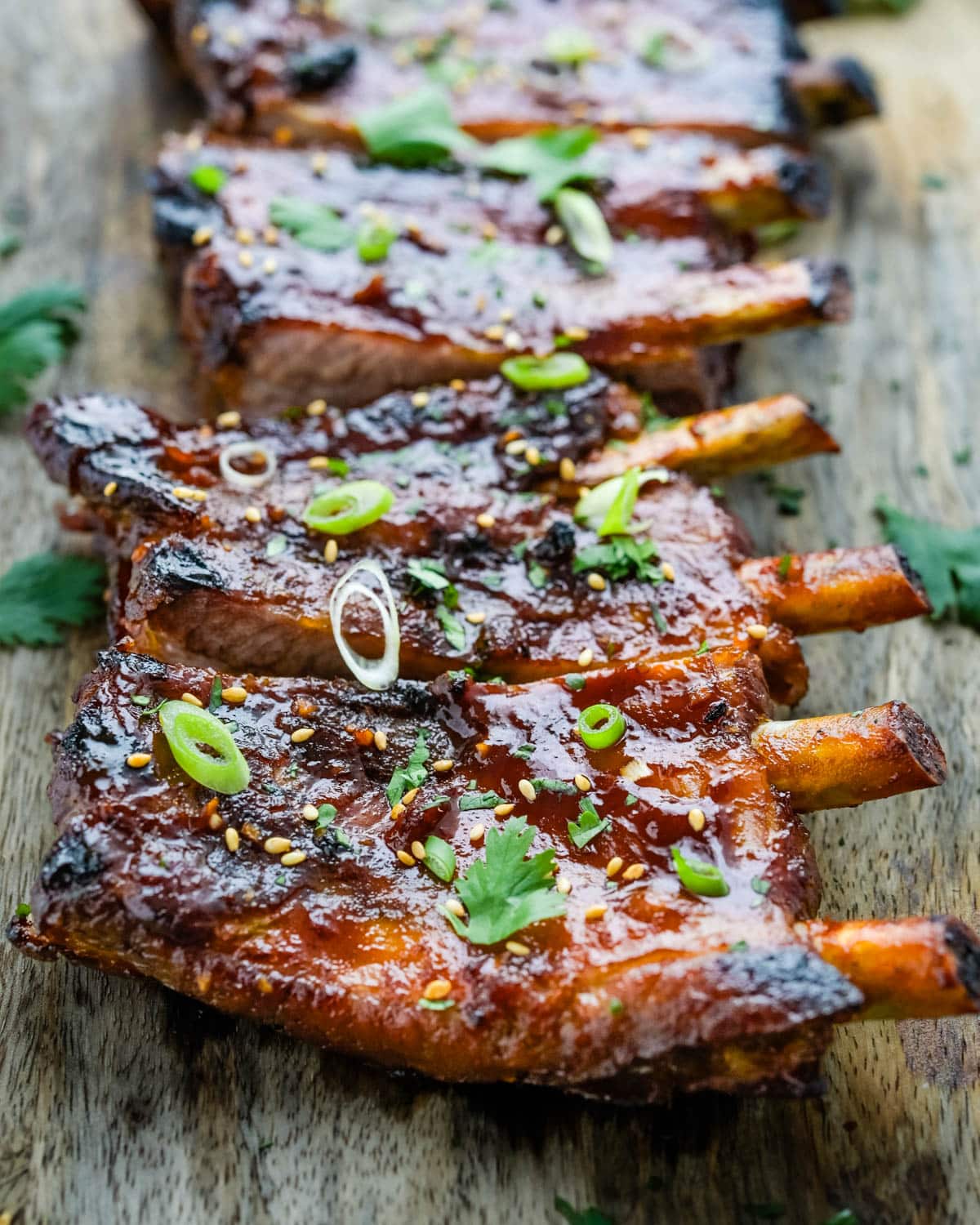
These pork spare ribs are my latest obsession. They are special because of the marinade and Korean BBQ sauce, which gives them a unique flavor from any others you’ve tried.
We like to serve them with this Quick Asian Cabbage Salad or this Asian Cucumber Salad with Peanuts and Sesame Seeds to round out a meal. They’re so juicy, tender, and flavorful; your family will think you’re a rib master!
Table of Contents
Why this recipe works for home cooks:
- The Korean BBQ sauce comes together in under 10 minutes and does triple duty as a marinade, glaze and dipping sauce.
- The meat is par-cooked in the oven using a moist-heat cooking method and finished on the grill or broiler, so it’s pretty hands-off.
- You can make as many racks as you like, just double the BBQ sauce recipe to ensure you’ve got enough.
- This is an excellent twist on standard American ribs and perfect for crowds and parties (think Super Bowl fare).
Ingredients:
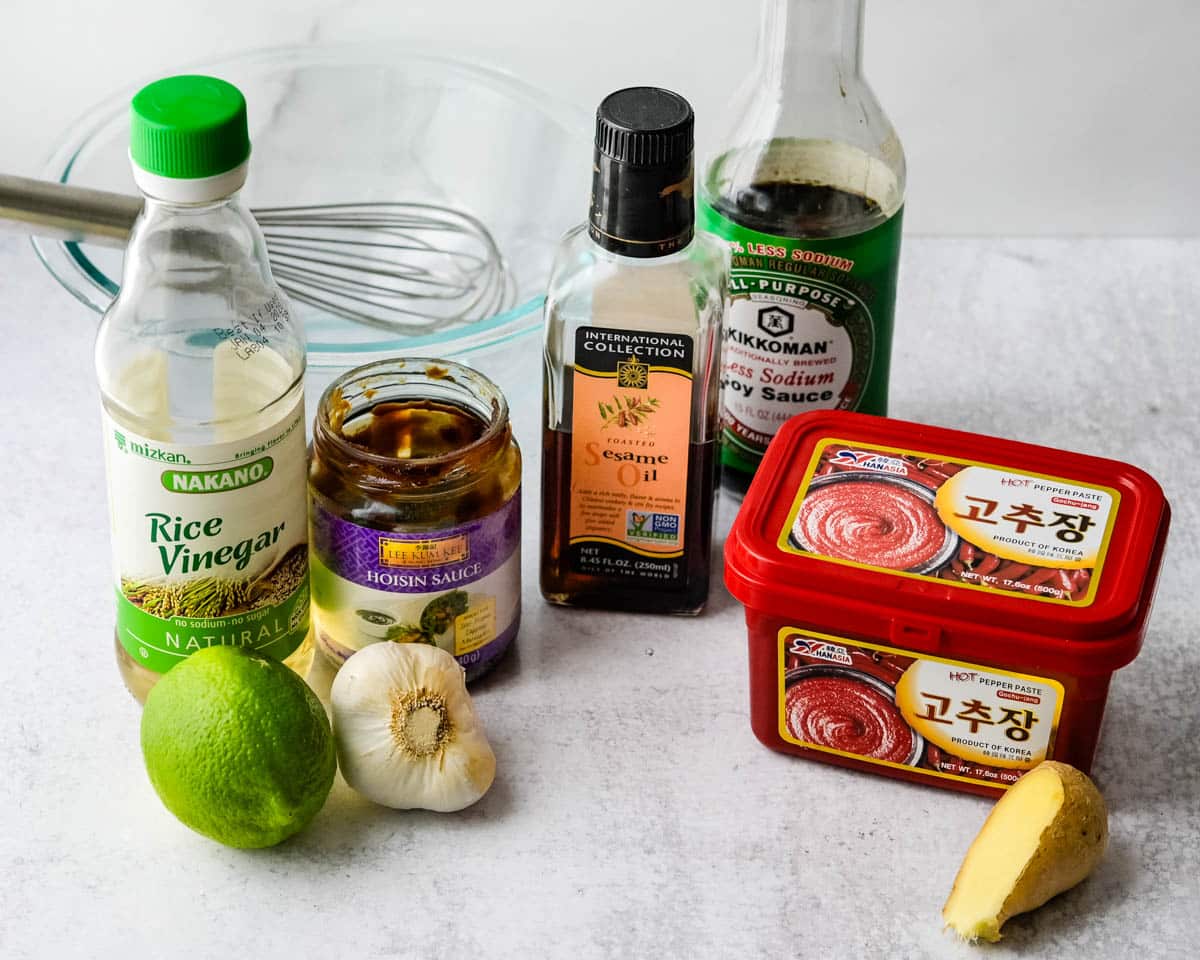
- Pork Spare Ribs – (not pictured) I get mine at Costco. They come two racks to a package, and the silver skin is removed for you, so you don’t need to fuss with it.
- Gochujang – you’ll find this spicy Korean paste at most grocery stores and all Asian markets. It’s a combination of red chilies, fermented soybean, rice and salt. The paste is thick and flavorful and gives this Korean BBQ sauce it’s authentic Korean flavor.
- Soy Sauce – I use low-sodium soy sauce, but you can use regular or substitute with Tamari.
- Hoisin Sauce – made from fermented soybean paste, this Chinese sauce is used for bbq sauces and to spread over Mu Shu Pork pancakes. It adds another layer of savory flavors to these Korean bbq ribs.
- Toasted Sesame Oil – has a warm nutty aroma and flavor that’s subtle, but noticeable.
- Rice Wine Vinegar – I used unseasoned rice vinegar, but you can also use seasoned.
- Brown Sugar – for sweetness. I prefer brown sugar to granulated for this because the molasses flavor pairs well with the soy sauce and Gochujang.
- Garlic – I recommend chopping fresh garlic cloves instead of pre-chopped garlic from a jar. There’s a big difference in flavor.
- Ginger – freshly grated ginger will give you the best flavor.
- Limes – you’ll use both the zest and juice for the Korean BBQ sauce and marinade.
- Orange Juice – adds a sweet citrus kick to the marinade and BBQ sauce.
- Garnishes – like extra Korean BBQ sauce, chopped green onion, fresh cilantro, toasted sesame seeds and lime wedges. These are optional, but they liven up the presentation.
Step-by-step instructions:

- Combine the Gochujang, soy sauce, hoisin, toasted sesame oil, rice wine vinegar, brown sugar, minced garlic and ginger, lime zest and juice and orange juice in a bowl and whisk to combine.

2. Transfer the pork ribs to a zip-top storage bag and pour half the marinade over the meat. Press out the excess air and seal the bag. Refrigerate for at least 4 hours or overnight.
Reserve the other half of the bbq sauce for grilling and serving.

3. Remove the Korean short ribs from the marinade and dry them off with paper towels. Fill a broiler pan with enough water to measure about ¼” deep. Set the broiler inset over the water and place the ribs over the vents.

4. Cover the ribs well with aluminum foil so that the ribs and broiler are sealed, and no steam can escape. Cook the Korean ribs in the oven for 2 hours and 15 minutes at 250° F.
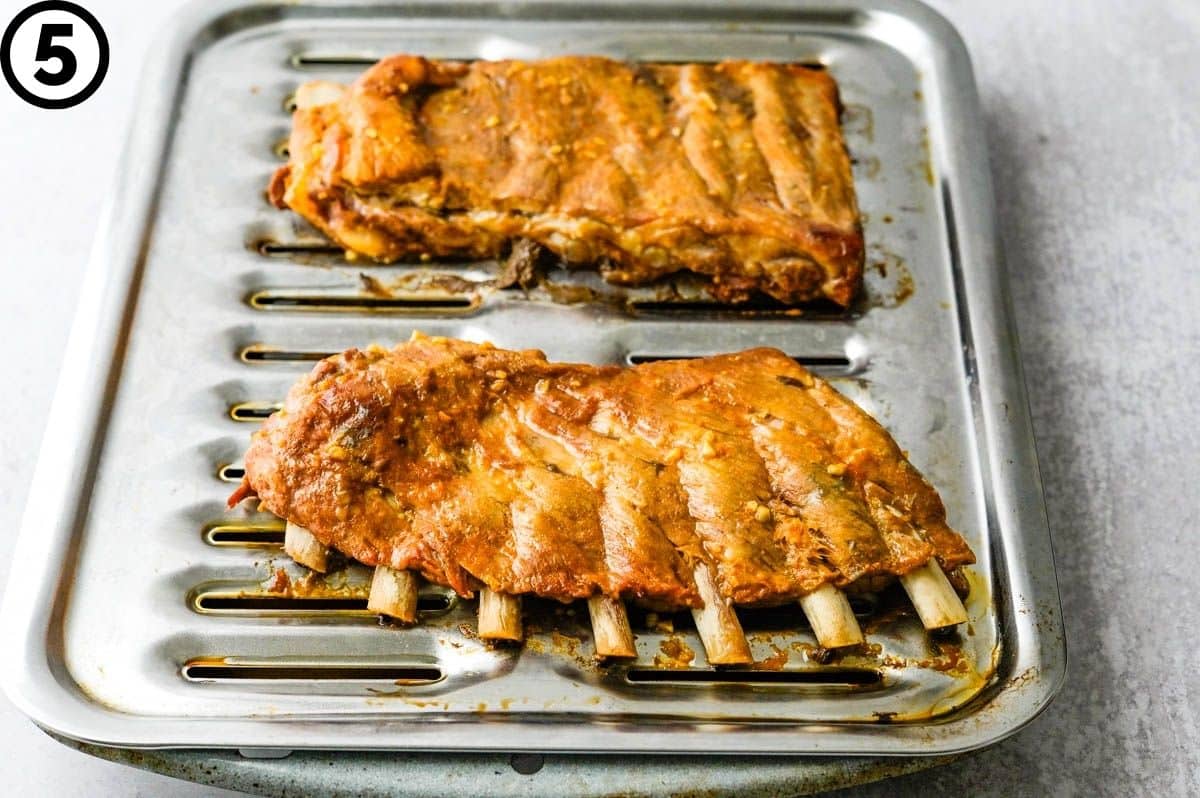
5. Once the Korean ribs are done braising, the meat shrinks back from the rib bones, so that they protrude from the rack. At this point the meat is tender and fully cooked, but still needs to be finished on the grill.
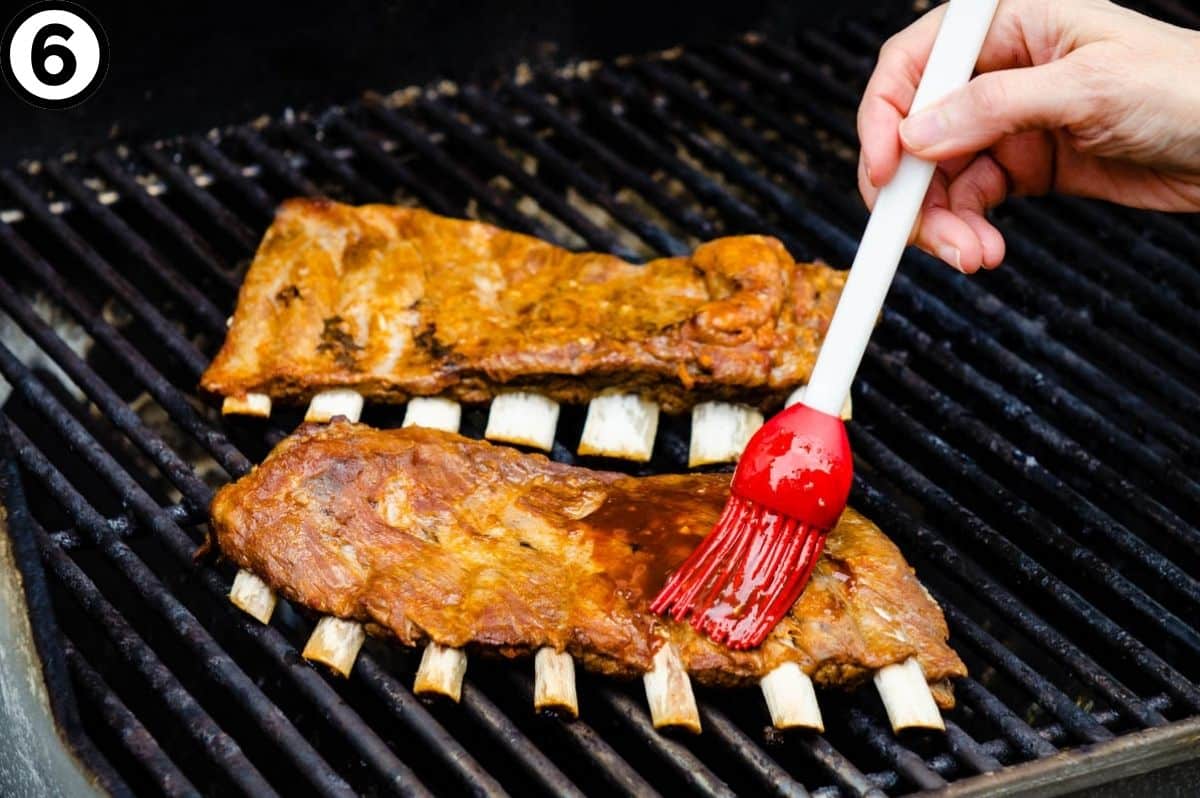
6. Preheat a charcoal or gas grill to a medium high heat (about 400 to 425° F). Pour half of the remaining Korean BBQ sauce into a small container and have a basting brush ready. Transfer the spareribs to the grill and brush with the BBQ sauce.
Alternatively, you can finish the ribs under the broiler element in your oven. Just lacquer the meat with BBQ sauce and place 4-5 inches under the broiler element. Cook for 3-4 minutes or until the sauce starts to brown and the edges get crusty. Flip the ribs and continue to broil for 3-4 more minutes.

7. Cook the Korean short ribs for about 4-5 minutes per side, brushing with the bbq sauce to give them a good lacquer and promote caramelization and browning. Serve with your favorite garnishes.
Pro-Tips:
- Check to see that the silver skin has been removed from the ribs before marinating. The one’s I get from Costco don’t have it, but if you’re getting them from another source, they may. Here’s how to remove silver skin from pork spareribs.
- If your pork ribs are fatty, trim the excess fat. The ones I get from Costco are well trimmed.
- To serve, cut the ribs into two three-bone portions to keep them juicy and prevent them from drying out.
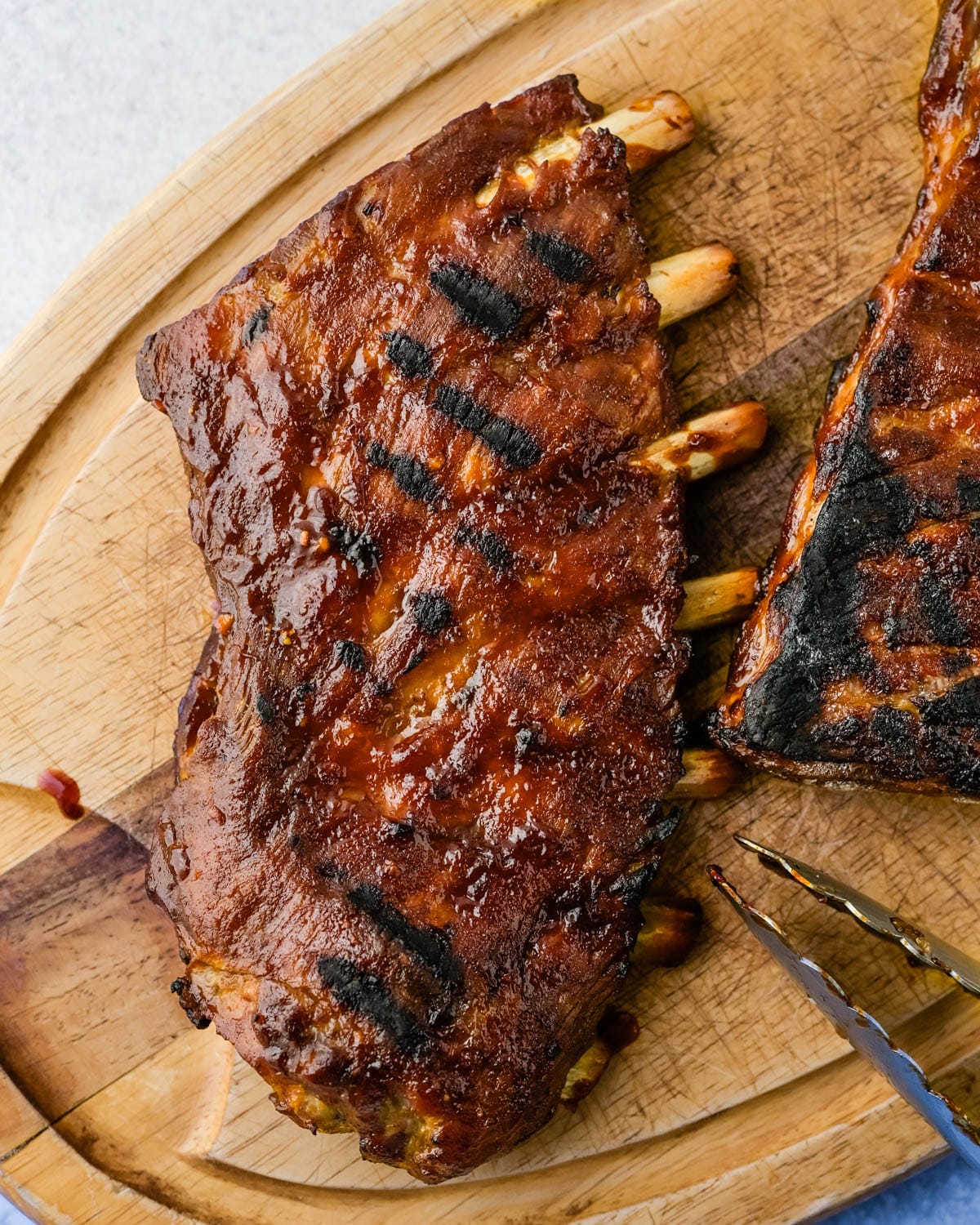
Variations:
- Add Asian Pear, a common ingredient in la Galbi and Korean BBQ recipes, but I can’t always find it in my market. If you do, peel an Asian pear and grate it with a box grater to add to the BBQ sauce. It helps tenderize the meat.
- Use beef short ribs instead of pork. The beef variety are much larger, usually coming 5-6 per package. They may take longer in the oven.
- Cook them on the grill, it does require more monitoring and finesse using a low and slow indirect cooking method. If interested, check out how we do it for these St. Louis style ribs. You can apply the same cooking to this recipe.
- Use the Instant Pot for another moist-heat method to par-cook the meat. Add a cup of cold water or apple juice to the bottom and place the steaming insert in the bottom of the pressure cooker. Add the ribs (you’ll have to cut them into smaller portions) and steam at full pressure for 35 minutes. Let the pressure reduce naturally. Then, proceed to the grill to finish them.
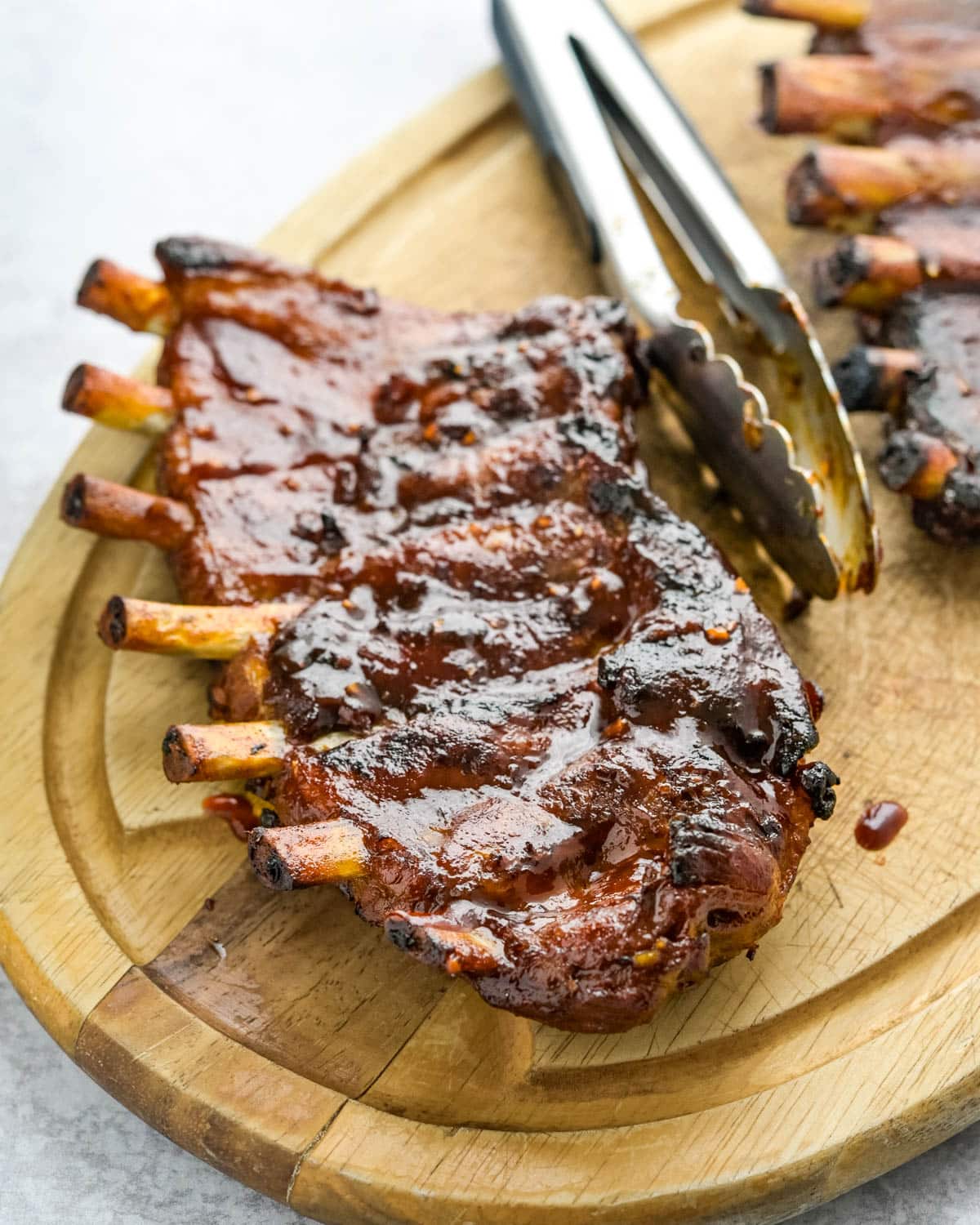
FAQ’s
Usually, Korean short ribs are made with thinly cut beef ribs (about ¼” thick). They are cut crosswise across the bone (flanken cut).
Beef ribs (a.k.a. plate short ribs or dino-ribs) are large beef ribs that can come from the animal’s rib, chuck, or plate primal cuts.
This Korean ribs recipe uses more common and less expensive pork spare ribs.
Bulgogi is made with a different cut of meat (brisket, tenderloin, sirloin or ribeye) altogether while galbi is made from beef short ribs, cut flanken style, thin cross sections.
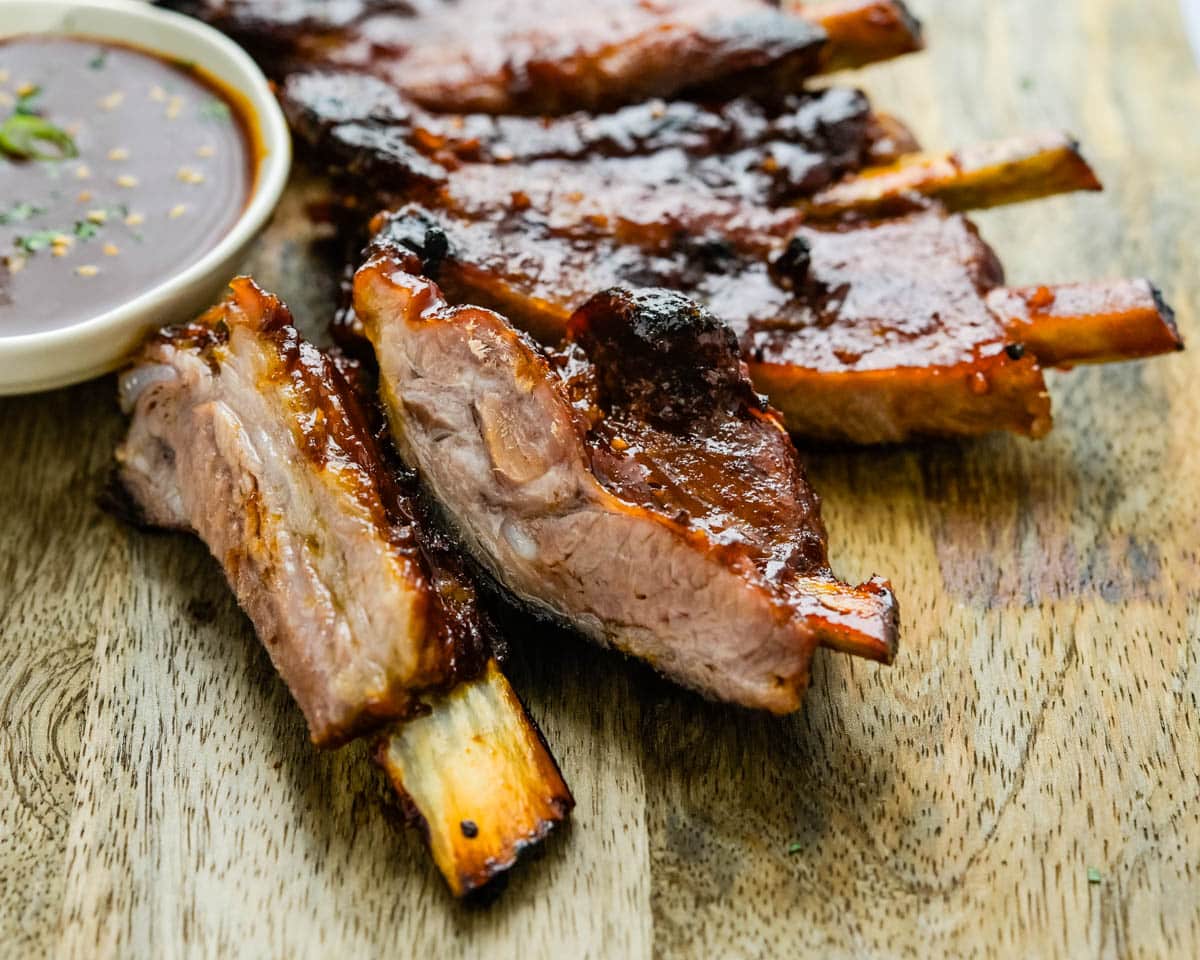
Storage and Freezing
- Store leftovers in the refrigerator, wrapped in aluminum foil.
- To reheat, place the foil packet in a 325° F oven for 10-12 minutes until the meat is heated through.
- Serve with leftover Korean BBQ sauce and freshly chopped green onion and cilantro along with other garnishes.
- Freeze leftovers wrapped in 2 layers of butcher or freezer paper for 2-3 months. Thaw before reheating.
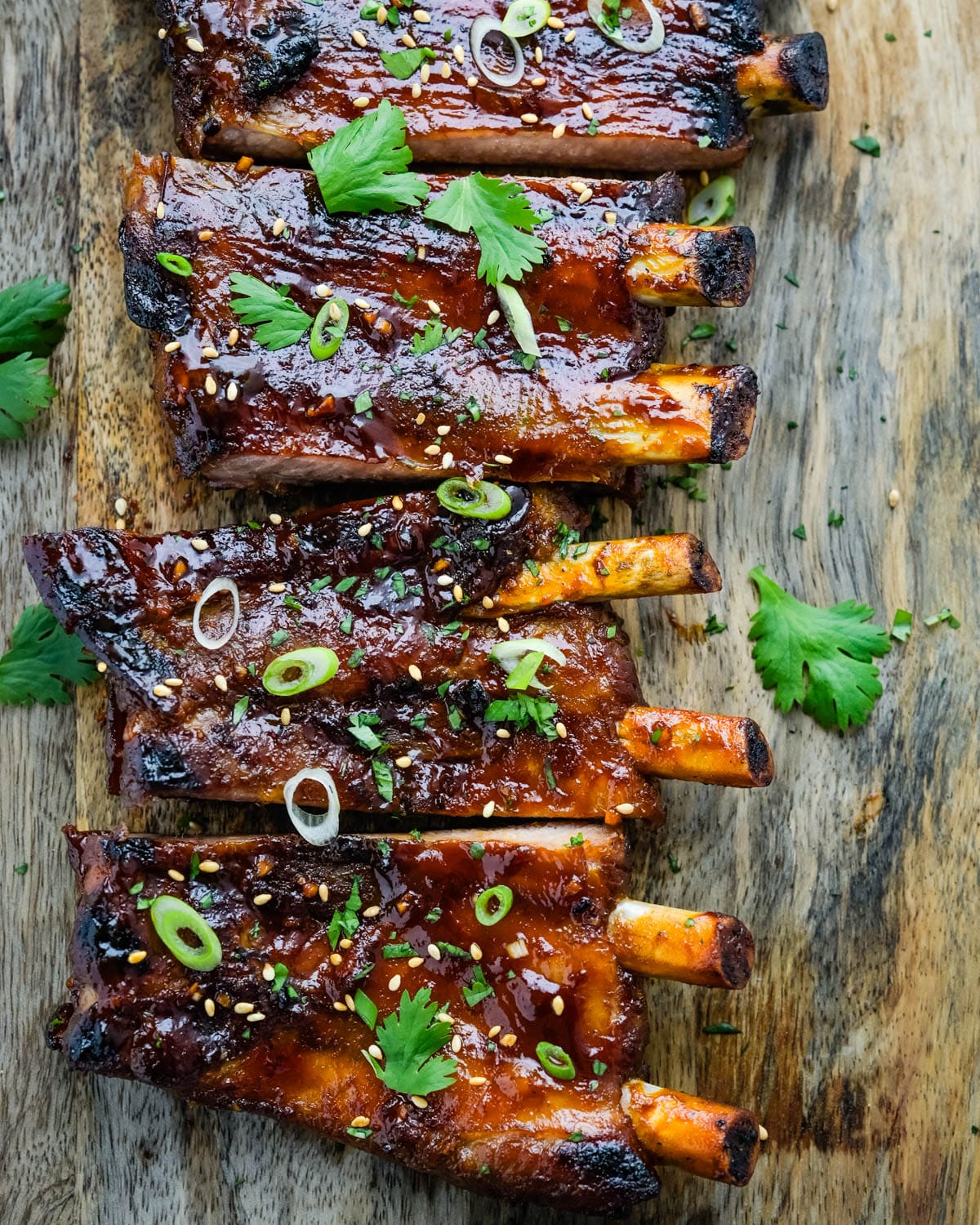
What to serve with Korean ribs:
- Kimchi is a delicious condiment to serve with this recipe. The fermented flavor of cabbage and veg plays well with the sweet, sticky, spicy meat.
- Steamed white rice seasoned with a few shakes of rice wine vinegar and topped with toasted sesame seeds and fresh cilantro.
- Spicy Edamame – since you’re eating the ribs with your fingers… might as well munch on pan-fried edamame (soy beans).
- Asian Cucumber Salad – this refreshing salad is a delicious accompaniment. It has great flavor and textures with a lip-smacking dressing and crunchy peanuts that set it off.
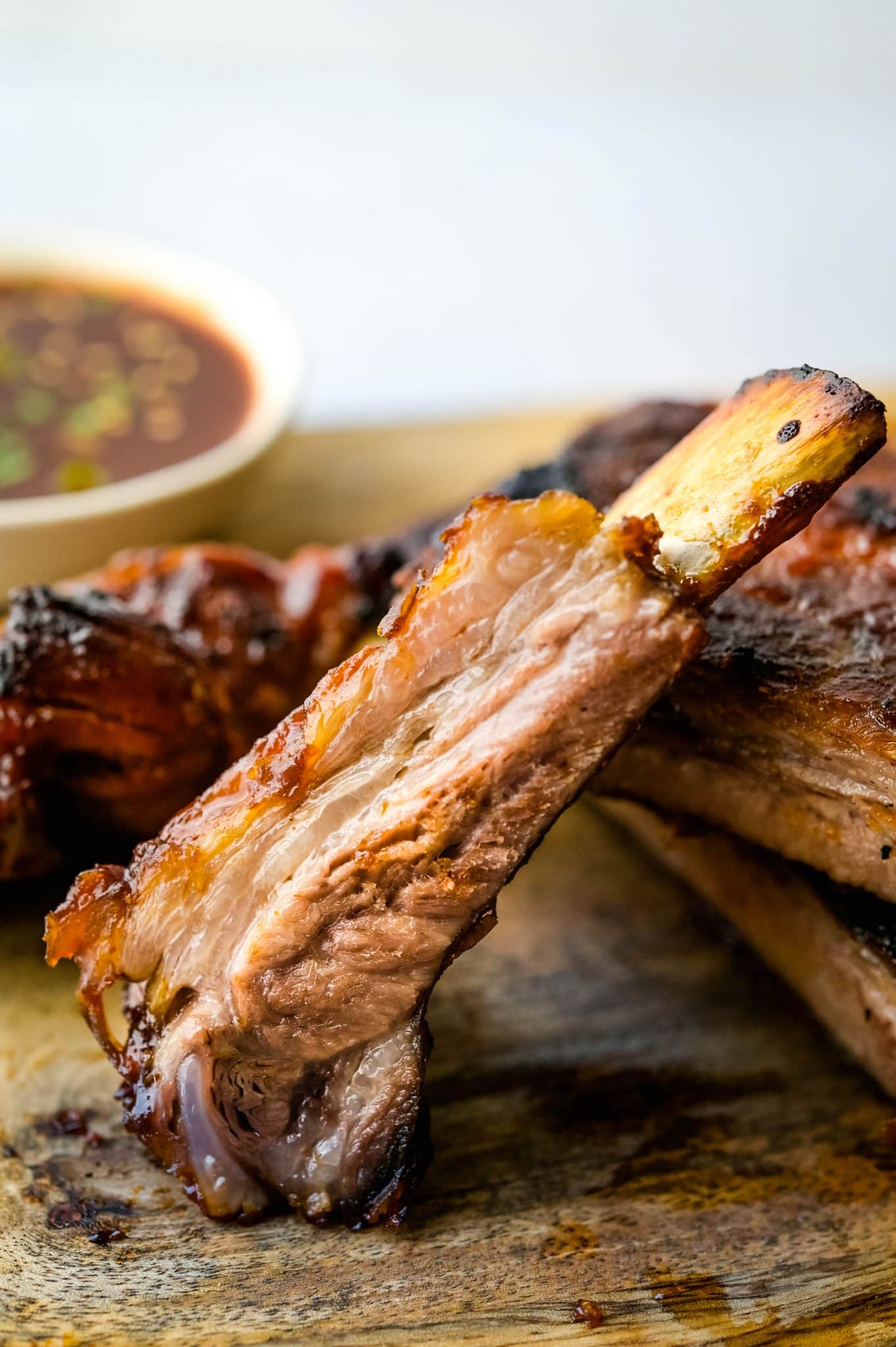
More rib and BBQ recipes:
- Kansas City Smoked Spareribs
- Smoked Pork Butt – Carolina Style
- Tender Hickory-Smoked Ribs
- Caribbean Jerk Smoked Pork
- Oven Baked Pork Spareribs
- Grilled Chicken Thighs with Herbed Spice Rub
- Barbecue Bacon Cheeseburgers

Tried this recipe? Leave a rating and review.
Your comments and shares are invaluable to me and the thousands of readers who use this site daily. If you've made the recipe, leave a star rating and review. We want to hear how you liked it.
We'd love it if you shared the recipe with your friends on social media!
Korean Short Ribs
INGREDIENTS:
- 2 racks pork spareribs
FOR THE KOREAN BBQ SAUCE:
- 1 cup gochujang
- ½ cup soy sauce
- ½ cup hoisin sauce
- 2 tablespoons sesame oil
- ¼ cup rice wine vinegar
- ½ cup brown sugar
- 2 tablespoons minced garlic about 4 large cloves
- 1 ½ tablespoon finely grated ginger
- 1 tablespoon lime zest (about 1 lime)
- ¼ cup lime juice (about 1 1/2 limes)
- ¼ cup orange juice
GARNISHES:
- extra reserved marinade
- green onion chopped
- cilantro chopped
- toasted sesame seeds chopped
- lime wedges
DIRECTIONS:
FOR THE KOREAN BBQ SAUCE & MARINADE:
- In a medium bowl, combine 1 cup gochujang, ½ cup soy sauce, ½ cup hoisin sauce, 2 tablespoons sesame oil, ¼ cup rice wine vinegar, ½ cup brown sugar, 2 tablespoons minced garlic, 1 ½ tablespoon finely grated ginger, 1 tablespoon lime zest, ¼ cup lime juice, and ¼ cup orange juice. Whisk until smooth.
- Peel the silver skin from 2 racks pork spareribs and discard. Transfer the ribs to a storage container or food storage bag (you may need to cut the racks in half to fit).
- Pour half of the marinade over the ribs to coat. Refrigerate 4 hours or overnight.
- Transfer the remainder of the marinade to a storage container and refrigerate until you’re ready to cook.
TO COOK THE RIBS:
- Preheat the oven to 250°.
- Remove the ribs from the marinade and pat to dry. Add just enough water to the bottom of a broiler pan to cover by about ¼”. Fit the rack insert onto the pan and rest the ribs on the rack. Cover them tightly with aluminum foil, so that no steam will escape.
- Transfer the ribs to the oven and cook until the ribs are tender, about 2 hrs 15 min.
- Divide the reserved Korean BBQ sauce in half. One half is for basting the ribs on the grill, and the other is for dipping when served.
TO FINISH KOREAN RIBS ON THE GRILL:
- To get a crusty exterior and laquer the ribs with the sauce, heat up a charcoal or gas grill to a medium high temperature (about 400°-425°).
- Transfer the ribs to the grill and brush with extra sauce. Cook on each side for about 4-5 minutes to get color and grill marks and to glaze the ribs.
TO FINISH KOREAN RIBS IN THE BROILER:
- Adjust the oven rack so the ribs will sit 4-5 inches under the heating element. Heat the broiler element on high. Brush the meat with BBQ sauce and set it under the heated broiler element. Cook for 3-4 minutes or until the sauce starts to brown and the edges get crusty. Flip the ribs and continue to broil for 3-4 more minutes.
GARNISH:
- Transfer to a cutting board and separate the ribs into 2-3 bone servings. Serve with extra reserved marinade, toasted sesame seeds, cilantro and green onion and lime wedges.
NOTES:
NUTRITION:
Pin “Korean Ribs” for later!
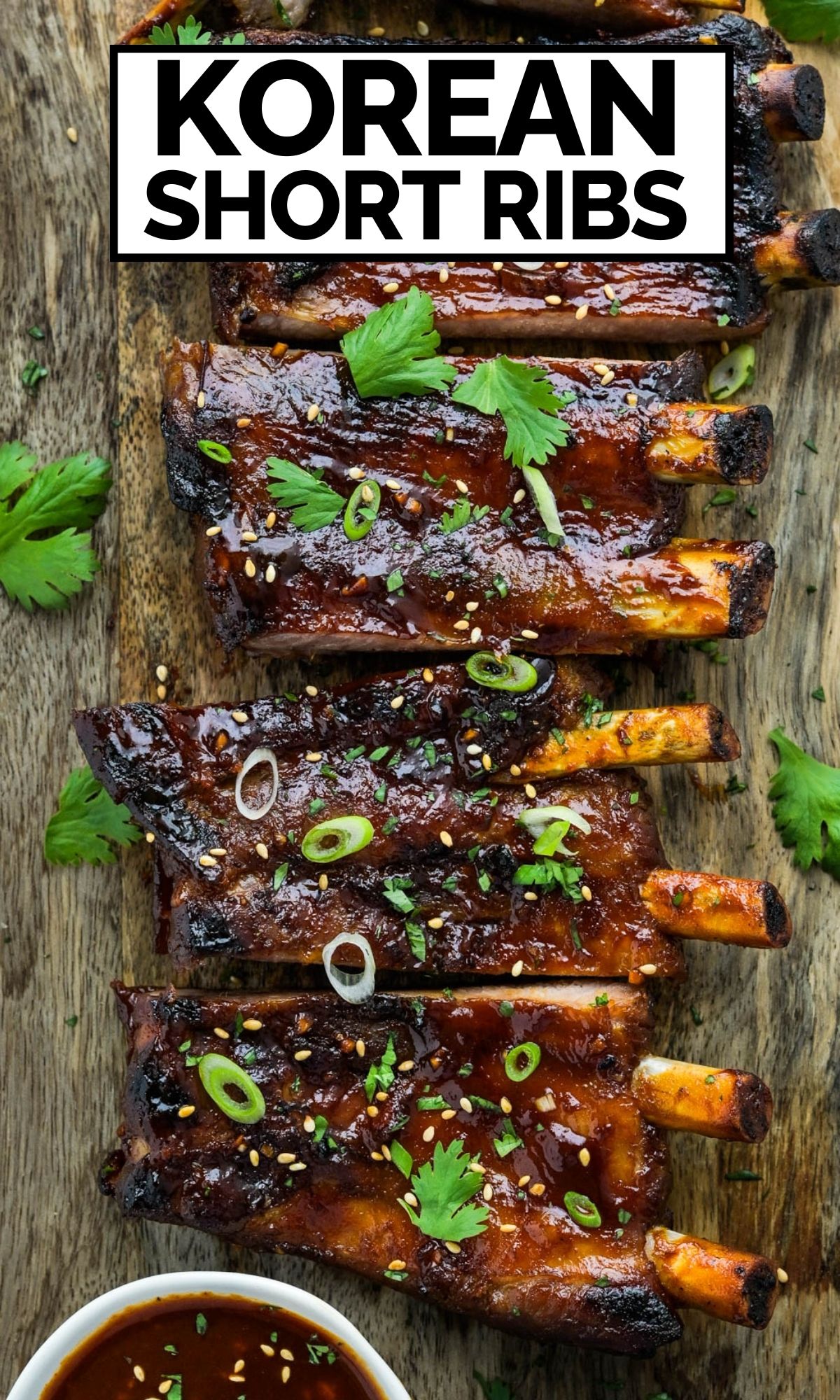

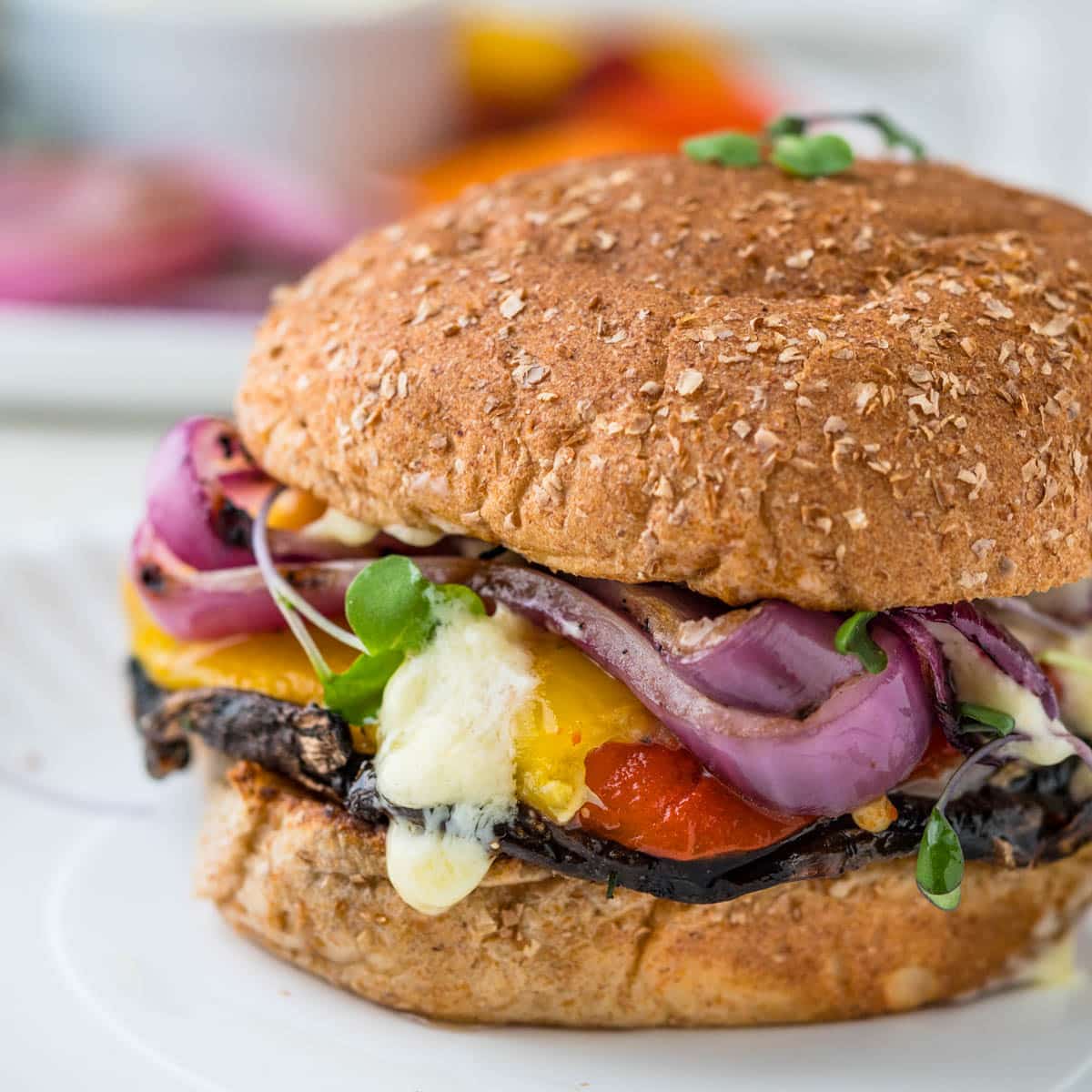
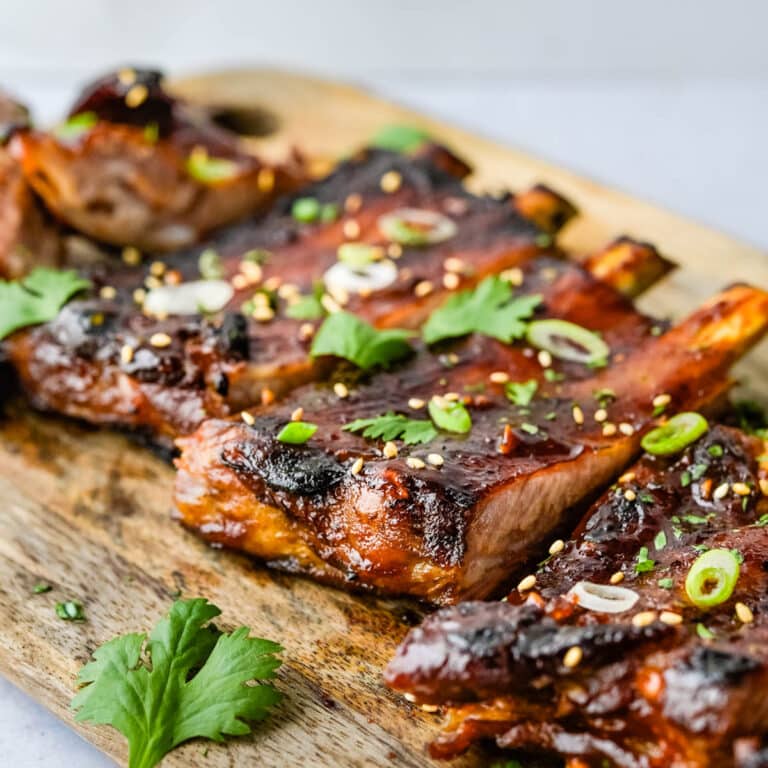
I made this!!! Bomb dot com
I’ve never had ribs like this before — they are so tender, juicy and flavorful! I will make this recipe again and again!
Love this recipe. However, the marinade needs to be cooked before using to dip. Microwave until it bubbles will do. The raw meat has to be cooked out of the marinade. Thanks. I love your stuff anyways looking for new ways to change up dinner.
If you follow the recipe instructions, the sauce used for dipping will not have touched raw meat – so your concern is unfounded. You only use one half of the sauce as the marinade. The other half is divided again, with part used to baste while grilling or broiling, and the other part used for dipping.
If you’re just going to cook them on the grill not on direct heat, what temp and how long?
I’d recommend setting up the grill for indirect heat at about 400° for 1 1/4 to 1 1/2 hours. The ribs are done when the meat shrinks back from the rib bone.
This recipe looks great. I plan on trying it in a few days. The ingredients obviously mentioned pork ribs, but can St. Louis style pork spare ribs be used in particular? Thanks in advance!
Absolutely!
Is it ok to use bone in Pork loin country style ribs? My husband bought them pre-cut.
yes, that should work fine.
What would your recommendation for cooking them in the slow cooker be? I don’t have a grill so that part is out either way, unless i crisped them up in a cast iron skillet.
These ribs turned out so perfect. I can promise you I don’t need a game to make these. My husband was thrilled with the flavor and raved about how tender these ribs were. Saving to make again.
That’s a perfect recipe for a good dinner party! I’m sure my friends would absolutely devour this!
I’m not a huge fan of football either but I love the party and the food. These would be a huge hit with all my kids because they love all Korean flavored food. Love all of your helpful photos and instructions!
Wish I was there when you made these ribs :). And I’d say this would be perfect for any occasion not only game day.
I do actually like football, but I’m all about the food on game day too. These ribs sound perfect. I think I could probably drink that sauce/marinade straight!